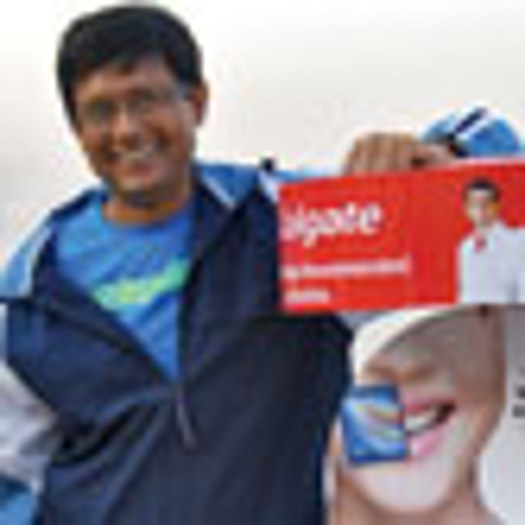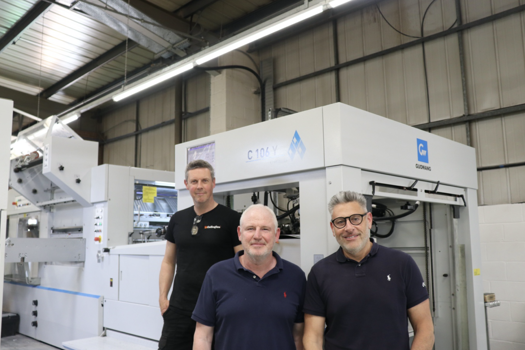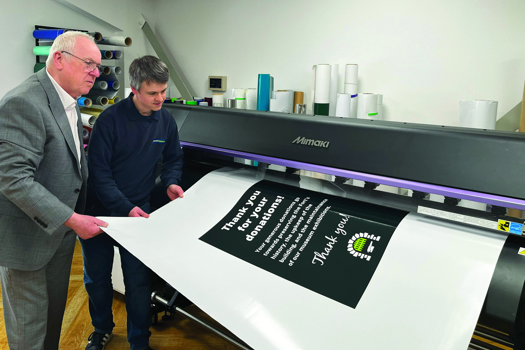Margins are getting lower. Increase print margins by 30%. Possible? Clients don’t want products, they want ideas. Possible? Ensure you are no longer a printer, but also an ad agency. Possible? I don’t know how to expand my client base. Think out of the box to attract pharma companies, white goods, financial services. All sectors are now approachable by you. Is it possible to think different? And finally, if a printer is tired of printing the same thing day in and day out. Then is it possible to do guerilla marketing, event branding, direct mailing, etc?
Some of the above is possible due to Clings, a substrate able to stick to almost any surface, including glass, plasterboard, wood, metal and brick, to get the message across. And just as importantly, Clings can be peeled off and used again. The ThinkCling media can be re-positioned but not re-applied over and over. In one or two reapplications, it loses its power. However, on first application, it clings on for months.
Says Murtaza Attari , the managing director of GMT that offers the substrate in India: " In India we don’t use Clings, but the brand-name ‘ThinkCling’. We have adopted this strategy, since we are positioning this medium as more of a creative solution instead of a media solution." And so, in all of GMT’s communication the company ensures they don’t talk about media properties, but creative solutions.
Attari says: "We offer our printer partners solutions that they can offer to their clients." In real terms this means, the client can have access to GMT’s data and case-studies, as well as it in-house team to develop creative solutions.
Attari adds: "That is why we say that our printer partners move from being a printer who walks into a client office with a material swatch, to a printer who walks into a client’s office with a creative presentation using his brand."
What is ThinkCling?
ThinkCling is one of a number of innovative substrates that have become available in recent years. This ‘smart substrate’ revolution has been aided by the continued advances in print technology – where once a number of different print and finishing processes were deployed, today digital is making everything far simpler. And, going by the evidence, smart substrates are opening up a world of possibilities.
According to Attari, the substrate is essentially a paper-thin polypropylene that has been embedded with an electrostatic charge. "It sticks in the same way that rubbing a balloon against your hair causes it stick," says Attari. "There’s no glue or adhesive on it at all."
Printers sometimes confuse ThinkCling with static cling vinyl, but Attari says a key difference is that it clings on to any substrate, even if it is not completely smooth. It doesn’t have to have to be glass but even a wood wall will do. One more thing is that it contains no PVC and so is fully recyclable. "The important thing I would say about this product is that it gives the printer a USP. Such a point of difference can really be crucial in what is a highly commoditised market."
What’s in store?
There are some other notable examples of smart substrates. Madico Graphic Films, for instance, produces screen protector labels for a number of camera and mobile phone manufacturers. The firm is close to introducing the same ‘easy-flow’ technology to the window graphics market.
This means people in retail outlets will be able to peel off a liner and apply it straight to the glass. And like a mobile phone protector label, it will just flow out on its own accord without any bumps or creases.
As Madico’s product underlines, smart substrates are often used because they make life easier for customers. They also help to reduce installation costs. Removing the extra expense of professional fitters for large-format display products has greatly benefited the retail sector, in particular.
As part of its 800-strong Euromedia range of roll-fed substrates, Fujifilm offers a number of products suitable for in-store and point-of-sale (POS) promotions. Launched in the summer of 2010, WonderTack Ghost is a clear PET substrate that adheres to smooth, flat surfaces without the use of adhesive. Instead, it has micro-porous suckers on the adhering side, and like so many of these smart substrates, is both repositionable and reusable.
Although the product is not yet available in India, it is a great example of a substrate that saves time and labour. For example, printers send the product to the retail outlet and store staff apply the signage themselves."
Another product that is benefitting the large-format display sector is Mirri from Celloglas. Mirri is a range of metallic papers and boards that, thanks to the advent of UV inkjet technology, can be printed on in one pass. It has been successfully trialled on an Agfa Anapurna, Fujifilm Sericol Inca and Roland DG LEC 550, and it has also been tested on an HP Indigo 5500 with the help of a primer coating followed by lamination.
Shyamlal Patnaik, who is an OOH media specialist says: "Mirri is a very good product from Celloglas. It is primarily deployed for POP, magazine dockets, in store branding on shelves, high end luxury products, CD cover." He adds: "Mirri is a leader in metallised paper and board. Metallisation is a process where thin metal foils are laminated on to paper and boards, and the product is used in print finish segments.
In addition, there’s Mirri foils, which are used in making metallised films for automotive graphics, which are widely used for two-wheelers and four-wheelers as decals. Screen printing is the technology that is generally used in these segments.
Mirri has been working hard behind the scenes since Ipex, talking to machine manufacturers and testing substrates on their machines. "The benefits of printing metallic using digital are profound. Before digital came along, a printer would have to guess whether you got the white layer right when printing it. Now, digital allows a printer to proof using Mirri as well."
Digital, of course, has enabled smart substrates to be used in short-run production. Says Patnaik, "Mirri is ideal for printers who want to produce stunning items in low quantities. It can be used by many printers in India, who will be doing lot of export orders for luxury magazines and direct mailers, etc.
Consider the ROI
During a panel discussion at the Indo German conference on consumables in Mumbai, Attari felt printers are often slow to embrace smart substrates, and justifying the extra cost of the substrate with the return-on-investment can sometimes be the sticking point. "A smart substrate can cost five times more than a conventional one, but the ROI could be 10 times more," he says.
"Personalisation is all about making the data work for you and your customers, and the use of new materials is an important way of doing that. Sadly, there are not enough printers who realise this."
One of the ideas Attari explored was that printers evaluate the cost of the media, not the value.
For example: ThinkCling media are compared to a vinyl or paper on a cost per sq inch basis. What one has to realise is that if the media is used effectively, it can not only create tremendous impact for a client but also brand space and engagement with the end consumer that cannot be done by traditional media.
In the Microsoft creative, one will see that we have got the benefit of an entire brand wall, by just using a small ThinkCling sticker.
Much of Attari’s ire lies at the feet of designers, who he believes often fail to grasp the commercial benefits digital technology brings. "Sometimes, designers don’t understand printers and vice versa. If it’s a personalised job, a designer should be aware of the need to use colour text and image variation, and not simply put black onto a textile." The issue is further complicated by the fact that digital print tends to be geared towards marketers as well, so there are three groups involved. "It’s a case of getting all the groups together and making them speak the same language," says Attari.
Patnaik concedes that, in some cases, suppliers are not doing enough to present to printers just how smart substrates can reduce some of their processes or enhance value. "One of the things we’re starting to do within our business is actually sit in front of printers and present our complete range. Most know about the standard, commodity-type products, but more needs to be done to make them aware of the more specialist items."
Customised solutions
For a number of suppliers, a consultative approach is the best way of getting that awareness across. A third of Madico’s business in Europe is project-based, meaning a substrate is specifically made to suit the needs of a particular customer.
"Sadly, too many printers are afraid to try new things and end up just competing on price. There are, however, plenty who embrace technologies, and we can assist them in entering new markets. These are the printers, who are making profit, basically," adds Attari.
By engaging more with suppliers, printers can also gain a greater understanding of trends in the marketplace. A good example is how environmentally conscious retailers are turning away from flex – there is talk of banning flex for in-store signage. Only by talking to suppliers can printers be made aware of the alternatives and therefore, offer different products to their customers.
"Ultimately, a good printer has got strong connections with the supplier, the designer, the customer and the end user," says B K Prakash of Insight Communication partners with HP and promoting HP’s PE media an environmentally safe substitute for flex. "It’s a no brainer – everybody’s happy."
Clearly, many printers are failing to reach that level of contentment. For those of you who are, perhaps an ‘Are you doing enough to embrace smart substrates?’ sticker on the factory wall could help?
Technology Monitor: Smart substrates create printing apps

Advances in paper, board and PVC have lead to the development of new kinds of print, which reduce some of the processes or enhance value, find out Tanvi Parekh and Ramu Ramanathan









